高中语法时态和语态
高中语法动词的时态和语态

一、一般现在时1、表示经常发生的习惯性的、现在反复出现的动作或状态,常用的时间状语有:always,usually,seldom, sometimes, every day, now and then, once a week等。
2、表示眼下或目前等现在时间所发生的动作或存在的状态,这种状态带有一定的持续性。
3、表示客观事实或普遍真理。
4、书报的标题,故事的叙述,小说、戏剧、电影等情节介绍,图片的说明等。
5、时间表、时刻表、日程表、节目单、课程表等按规定将要发生的动作,只限于go, arrive, leave, start, stay, return, begin, come等动词。
6、在时间、条件、方式、让步状语从句中,表示将来的动作。
注意:一般现在时可以用于定语从句或宾语从句中表示将来。
7、用在某些表达中,表示现在正在发生的动作或存在的状态。
Here comes the bus!How it rains!二、一般过去时1、表示在过去某一时间点发生的动作或所处的状态,与现在没有关系。
常用的时间状语有:yesterday, last night, at that time等。
2、表示在过去某一段时间里反复出现的动作或状态,与现在没有关系。
3、用used to do或would do表示过去经常或反复发生的动作。
4、有些情况发生的时间没清楚表明,但实际上是“刚才,刚刚”发生的,属于过去时间,应使用过去时态。
常见的有I didn’t know…或I forgot…等。
5、一般过去时可与today, this week, this month等时间状语连用。
三、一般将来时1、will/shall do(1)表示将来会出现的动作或状态。
常用的时间状语:this evening, tomorrow, next week/month…,at the end of this term, in a few minutes等。
高中英语语法必备之谓语动词的时态和语态详解
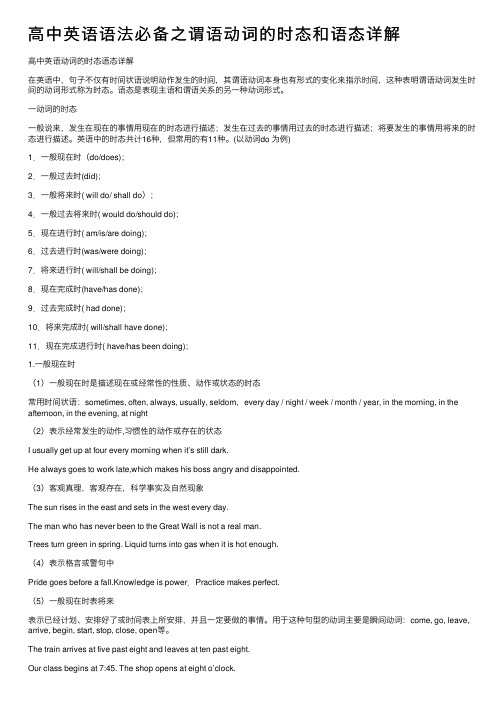
⾼中英语语法必备之谓语动词的时态和语态详解⾼中英语动词的时态语态详解在英语中,句⼦不仅有时间状语说明动作发⽣的时间,其谓语动词本⾝也有形式的变化来指⽰时间,这种表明谓语动词发⽣时间的动词形式称为时态。
语态是表现主语和谓语关系的另⼀种动词形式。
⼀动词的时态⼀般说来,发⽣在现在的事情⽤现在的时态进⾏描述;发⽣在过去的事情⽤过去的时态进⾏描述;将要发⽣的事情⽤将来的时态进⾏描述。
英语中的时态共计16种,但常⽤的有11种。
(以动词do 为例)1.⼀般现在时(do/does);2.⼀般过去时(did);3.⼀般将来时( will do/ shall do);4.⼀般过去将来时( would do/should do);5.现在进⾏时( am/is/are doing);6.过去进⾏时(was/were doing);7.将来进⾏时( will/shall be doing);8.现在完成时(have/has done);9.过去完成时( had done);10.将来完成时( will/shall have done);11.现在完成进⾏时( have/has been doing);1.⼀般现在时(1)⼀般现在时是描述现在或经常性的性质、动作或状态的时态常⽤时间状语:sometimes, often, always, usually, seldom,every day / night / week / month / year, in the morning, in the afternoon, in the evening, at night(2)表⽰经常发⽣的动作,习惯性的动作或存在的状态I usually get up at four every morning when it’s still dark.He always goes to work late,which makes his boss angry and disappointed.(3)客观真理,客观存在,科学事实及⾃然现象The sun rises in the east and sets in the west every day.The man who has never been to the Great Wall is not a real man.Trees turn green in spring. Liquid turns into gas when it is hot enough.(4)表⽰格⾔或警句中Pride goes before a fall.Knowledge is power.Practice makes perfect.(5)⼀般现在时表将来表⽰已经计划、安排好了或时间表上所安排,并且⼀定要做的事情。
高中英语语法时态和语态课件(共69张PPT)
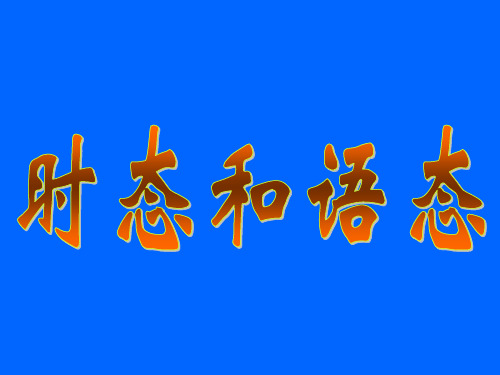
--ann is in hospital.
--yes, i know. i’m going to visit her tomorrow.
--oh,really? i didn’t know. i’ll go and visit her. 2〕表示迹象表明要发生某事,则只能用be going to,e.g.
look at the dark clouds.it’s going to rain. 3〕be going to还有以下用法,e.g. ①强调主观想法或意图: i’m going to wash the car if i have time. (注意:此时
②It was then a small fishing village.
2.特别用法:
1〕表客气或委婉的现在:
①I wondered if you were free this evening.
②I thought you might like some flowers.
(注:过去进行时也可表示现在使语气更委婉、客气,eg.① I was wondering if you could give me a lift. ②We were hoping you would stay with us.能这样用的动 词主要限于want, wonder , think, hope, intend等少数 动词。)
②Someone has broken the window.(结果: 窗户仍破 着)
2〕持续性用法:该用法表示一个过去发生的动作在过去 并未在过去完成,而是持续到现在,且可能继续持续下去 或可能到此结束,e.g.
高中英语最基础语法概念时态、语态和语气素材
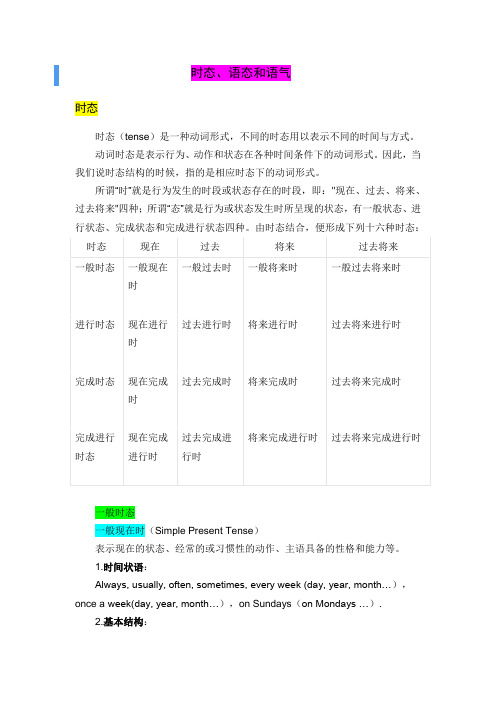
时态、语态和语气一般时态一般现在时(Simple Present Tense)表示现在的状态、经常的或习惯性的动作、主语具备的性格和能力等。
1.时间状语:Always, usually, often, sometimes, every week (day, year, month…),once a week(day, year, month…),on Sundays(on Mondays …).2.基本结构:一般过去时(Simple Past Tense)表示过去某个时间内(或某一段时间内)发生的动作或存在的状态,过去经常或反复发生的动作。
1.时间状语:ago, yesterday, the day before yesterday, last week, last(year, night, month…),in 1989,just now, at the age of 5,one day, long long ago, once upona time, etc.2.基本结构:主语+ 动词的过去式或be的过去式+名词。
3.否定形式:主语+ was/were + not + 其他(在行为动词前加didn't,同时还原行为动词)。
4.一般疑问句:was或were放于句首;用助动词do的过去式did 提问,同时还原行为动词。
例句:(1)She often came to help us in those days.那些天她经常来帮助我们。
(2)I didn't know you were so busy.我不知道你是这么忙。
一般将来时表示将要发生的动作、打算、计划或准备做某事。
1.时间状语:Tomorrow, soon, in a few minutes, ,the day after tomorrow, etc.2.基本结构:(1)主语+ am/is/are + going to + do sth(2)主语+ will/shall + do sth3.否定句:在系动词is/am/are或情态动词will/shall后加not4.一般疑问句:be放于句首;will/shall提到句首。
(完整版)高中语法之常用时态语态详解

第四章时态和语态一.动词的时态英语时态用共有十六种时态,其中常用的有8种,它们是:一般现在时、一般过去时、一般将来时、现在进行时、现在完成时、过去进行时、过去完成时和过去将来时。
一. 一般现在时.1.构成. be动词:am is are ; 其他动词用动词原形,当主语是第三人称单数时要在谓语动词后加“s”,其变化规则与名词变复数一致。
2.用法. 1). 经常性或习惯性的动作,常与表示频度的时间状语连用。
如usually, always, often, seldom, never, every...,eg. I leave home for school at 7 every morning.I don’t leave home for school at 7 every morning.Do I leave home for school at 7 every morning?He usually gets up early.He doesn’t usually get up early.Does he usually get up early?2) 客观真理,客观存在,科学事实。
eg. The earth moves around the sun.The earth doesn’t move around the sun 否定句Does the earth move around the sun? 疑问句Shanghai lies in the east of China.Shanghai doesn’t lie in the east of China 否定句Does Shanghai lie in the east of China? 疑问句Water boils at 100 centigrade degrees.3) 表示格言或警句中eg. Pride goes before a fall.注意. 此用法如果出现在宾语从句中,即使主句是过去时,从句谓语也要用一般现在时。
高中英语时态语态总结
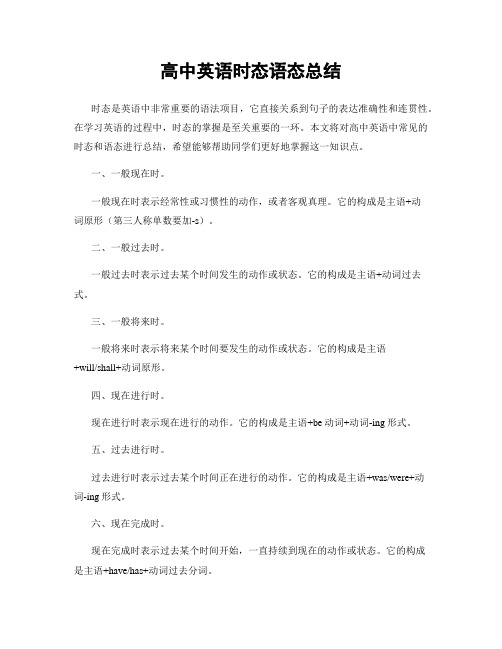
高中英语时态语态总结时态是英语中非常重要的语法项目,它直接关系到句子的表达准确性和连贯性。
在学习英语的过程中,时态的掌握是至关重要的一环。
本文将对高中英语中常见的时态和语态进行总结,希望能够帮助同学们更好地掌握这一知识点。
一、一般现在时。
一般现在时表示经常性或习惯性的动作,或者客观真理。
它的构成是主语+动词原形(第三人称单数要加-s)。
二、一般过去时。
一般过去时表示过去某个时间发生的动作或状态。
它的构成是主语+动词过去式。
三、一般将来时。
一般将来时表示将来某个时间要发生的动作或状态。
它的构成是主语+will/shall+动词原形。
四、现在进行时。
现在进行时表示现在进行的动作。
它的构成是主语+be动词+动词-ing形式。
五、过去进行时。
过去进行时表示过去某个时间正在进行的动作。
它的构成是主语+was/were+动词-ing形式。
六、现在完成时。
现在完成时表示过去某个时间开始,一直持续到现在的动作或状态。
它的构成是主语+have/has+动词过去分词。
七、过去完成时。
过去完成时表示过去某个时间之前已经完成的动作或状态。
它的构成是主语+had+动词过去分词。
八、一般将来完成时。
一般将来完成时表示将来某个时间之前已经完成的动作或状态。
它的构成是主语+will/shall+have+动词过去分词。
九、被动语态。
被动语态表示主语是动作的承受者。
它的构成是be动词+动词过去分词。
十、情态动词。
情态动词包括can, could, may, might, must, shall, should, will, would等。
它们用来表示说话人的态度、情感或推测。
总结,时态和语态是英语语法中的重要内容,它们直接关系到句子的表达准确性。
在学习过程中,我们要多加练习,多加总结,才能够真正掌握好这一知识点。
希望本文的总结能够帮助大家更好地理解和掌握高中英语中的时态和语态。
高二英语知识点归纳语法知识点总结
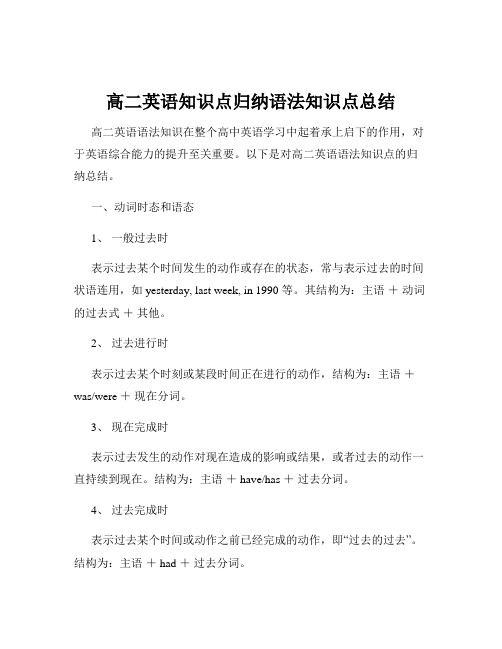
高二英语知识点归纳语法知识点总结高二英语语法知识在整个高中英语学习中起着承上启下的作用,对于英语综合能力的提升至关重要。
以下是对高二英语语法知识点的归纳总结。
一、动词时态和语态1、一般过去时表示过去某个时间发生的动作或存在的状态,常与表示过去的时间状语连用,如 yesterday, last week, in 1990 等。
其结构为:主语+动词的过去式+其他。
2、过去进行时表示过去某个时刻或某段时间正在进行的动作,结构为:主语+was/were +现在分词。
3、现在完成时表示过去发生的动作对现在造成的影响或结果,或者过去的动作一直持续到现在。
结构为:主语+ have/has +过去分词。
4、过去完成时表示过去某个时间或动作之前已经完成的动作,即“过去的过去”。
结构为:主语+ had +过去分词。
5、一般将来时表示将来要发生的动作或存在的状态,结构有:will +动词原形、be going to +动词原形等。
6、将来进行时表示将来某个时刻正在进行的动作,结构为:will be +现在分词。
7、被动语态强调动作的承受者,结构为:be +过去分词。
各种时态都有相应的被动语态形式。
二、非谓语动词1、动词不定式具有名词、形容词和副词的特征,在句中可作主语、宾语、定语、状语等。
2、动名词具有名词的特征,可作主语、宾语、定语等。
3、分词包括现在分词和过去分词。
现在分词表示主动和进行,过去分词表示被动和完成。
分词在句中可作定语、状语、宾语补足语等。
三、定语从句1、关系代词引导的定语从句关系代词有 that, which, who, whom, whose 等,在从句中充当主语、宾语、定语等成分。
2、关系副词引导的定语从句关系副词有 when, where, why 等,在从句中充当状语。
四、名词性从句1、主语从句在复合句中充当主语的从句,常见的引导词有 that, whether, what 等。
2、宾语从句在复合句中充当宾语的从句,引导词有 that, if/whether, what 等。
高中英语语法总结大全之动词的时态_语态

动词的时态、语态一般现在时的用法1) 经常性或习性的动作,常与表示频度的时间状语连用。
时间状语:every…, sometimes, at…, on SundayI leave home for school at 7 every morning.2) 客观真理,客观存在,科学事实。
The earth moves around the sun. Shanghai lies in the east of China.3) 表示格言或警句中。
Pride goes before a fall. 骄者必败。
注意:此用法如果出现在宾语从句中,即使主句是过去时,从句谓语也要用一般现在时。
例:Columbus proved that the earth is round..4) 现在时刻的状态、能力、性格、个性。
Ann writes good English but does not speak well.比较:Now I put the sugar in the cup. I am doing my homework now.5)在连词when, while, if, unless, as soon as等引导的时间状语从句和条件状语从句中,用一般现在时态代替将来时。
Unless some extra money is found, the theatre will close.现在完成时现在完成时用来表示动作或状态发生在过去但它的影响现在还存在;也可表示持续到现在的动作或状态。
其构成: have (has) +过去分词。
Ann has worked for a long time to realize his dream and now he is popular.比较过去时与现在完成时1)过去时表示过去某时发生的动作或单纯叙述过去的事情,强调动作;现在完成时为过去发生的,强调过去的事情对现在的影响,强调的是影响。
(完整)高中英语语法(时态和语态)
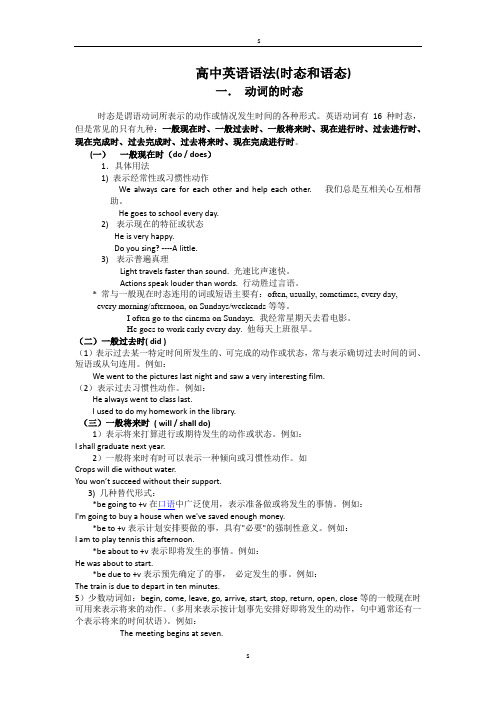
高中英语语法(时态和语态)一.动词的时态时态是谓语动词所表示的动作或情况发生时间的各种形式。
英语动词有16种时态,但是常见的只有九种:一般现在时、一般过去时、一般将来时、现在进行时、过去进行时、现在完成时、过去完成时、过去将来时、现在完成进行时。
(一)一般现在时(do / does)1.具体用法1) 表示经常性或习惯性动作We always care for each other and help each other. 我们总是互相关心互相帮助。
He goes to school every day.2)表示现在的特征或状态He is very happy.Do you sing? ----A little.3)表示普遍真理Light travels faster than sound. 光速比声速快。
Actions speak louder than words. 行动胜过言语。
* 常与一般现在时态连用的词或短语主要有:often, usually, sometimes, every day,every morning/afternoon, on Sundays/weekends等等。
I often go to the cinema on Sundays. 我经常星期天去看电影。
He goes to work early every day. 他每天上班很早。
(二)一般过去时( did )(1)表示过去某一特定时间所发生的、可完成的动作或状态,常与表示确切过去时间的词、短语或从句连用。
例如:We went to the pictures last night and saw a very interesting film.(2)表示过去习惯性动作。
例如:He always went to class last.I used to do my homework in the library.(三)一般将来时( will / shall do)1)表示将来打算进行或期待发生的动作或状态。
高中必修一英语语法整理总结
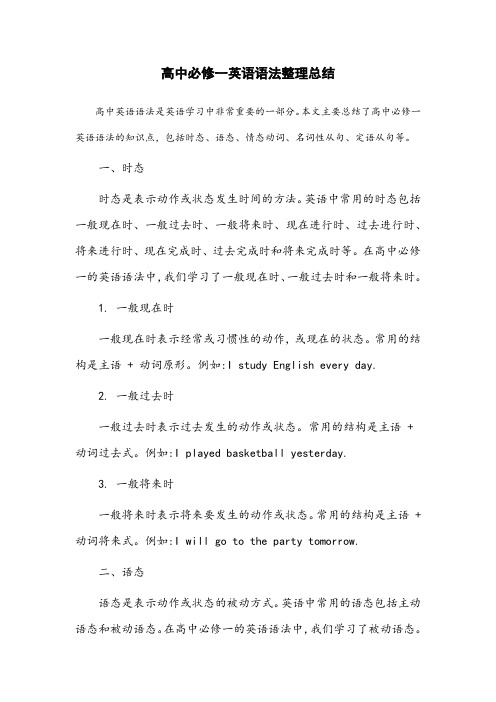
高中必修一英语语法整理总结高中英语语法是英语学习中非常重要的一部分。
本文主要总结了高中必修一英语语法的知识点,包括时态、语态、情态动词、名词性从句、定语从句等。
一、时态时态是表示动作或状态发生时间的方法。
英语中常用的时态包括一般现在时、一般过去时、一般将来时、现在进行时、过去进行时、将来进行时、现在完成时、过去完成时和将来完成时等。
在高中必修一的英语语法中,我们学习了一般现在时、一般过去时和一般将来时。
1. 一般现在时一般现在时表示经常或习惯性的动作,或现在的状态。
常用的结构是主语 + 动词原形。
例如:I study English every day.2. 一般过去时一般过去时表示过去发生的动作或状态。
常用的结构是主语 + 动词过去式。
例如:I played basketball yesterday.3. 一般将来时一般将来时表示将来要发生的动作或状态。
常用的结构是主语 + 动词将来式。
例如:I will go to the party tomorrow.二、语态语态是表示动作或状态的被动方式。
英语中常用的语态包括主动语态和被动语态。
在高中必修一的英语语法中,我们学习了被动语态。
1. 被动语态被动语态表示主语是动作的承受者。
常用的结构是 be + 过去分词。
例如:The book was read by the teacher.三、情态动词情态动词是表示能力、可能性或义务的动词。
英语中常用的情态动词包括 can、may、must、should、will 等。
在高中必修一的英语语法中,我们学习了情态动词的用法和意义。
1. cancan 表示能力或允许。
例如:I can speak English.2. maymay 表示可能性或允许。
例如:You may come to my party.3. mustmust 表示肯定或义务。
例如:He must study hard.4. shouldshould 表示应该或义务。
高中语法复习动词时态与语态
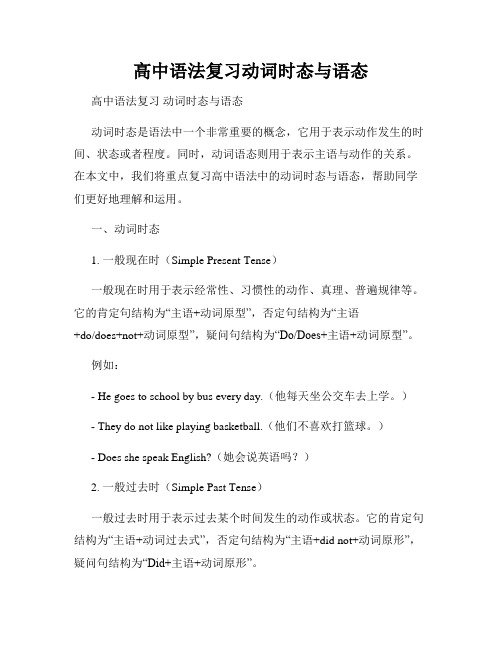
高中语法复习动词时态与语态高中语法复习动词时态与语态动词时态是语法中一个非常重要的概念,它用于表示动作发生的时间、状态或者程度。
同时,动词语态则用于表示主语与动作的关系。
在本文中,我们将重点复习高中语法中的动词时态与语态,帮助同学们更好地理解和运用。
一、动词时态1. 一般现在时(Simple Present Tense)一般现在时用于表示经常性、习惯性的动作、真理、普遍规律等。
它的肯定句结构为“主语+动词原型”,否定句结构为“主语+do/does+not+动词原型”,疑问句结构为“Do/Does+主语+动词原型”。
例如:- He goes to school by bus every day.(他每天坐公交车去上学。
)- They do not like playing basketball.(他们不喜欢打篮球。
)- Does she speak English?(她会说英语吗?)2. 一般过去时(Simple Past Tense)一般过去时用于表示过去某个时间发生的动作或状态。
它的肯定句结构为“主语+动词过去式”,否定句结构为“主语+did not+动词原形”,疑问句结构为“Did+主语+动词原形”。
例如:- I watched a movie last night.(昨晚我看了一场电影。
)- They did not go to the party.(他们没有参加派对。
)- Did you finish your homework?(你完成作业了吗?)3. 一般将来时(Simple Future Tense)一般将来时用于表示将来某个时间会发生的动作或状态。
它的肯定句结构为“主语+will+动词原形”,否定句结构为“主语+will not+动词原形”,疑问句结构为“Will+主语+动词原形”。
例如:- She will go to Beijing next week.(她下周将去北京。
)- We will not have a meeting tomorrow.(明天我们不开会。
时态与语态(英语语法)
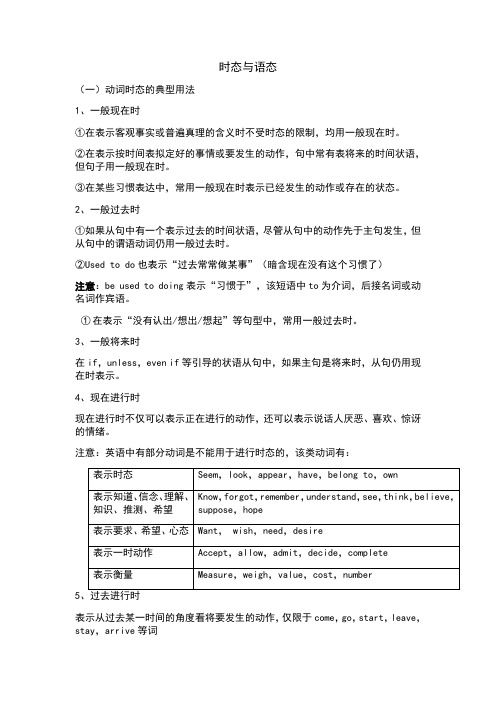
时态与语态(一)动词时态的典型用法1、一般现在时①在表示客观事实或普遍真理的含义时不受时态的限制,均用一般现在时。
②在表示按时间表拟定好的事情或要发生的动作,句中常有表将来的时间状语,但句子用一般现在时。
③在某些习惯表达中,常用一般现在时表示已经发生的动作或存在的状态。
2、一般过去时①如果从句中有一个表示过去的时间状语,尽管从句中的动作先于主句发生,但从句中的谓语动词仍用一般过去时。
②U sed to do也表示“过去常常做某事”(暗含现在没有这个习惯了)注意:be used to doing表示“习惯于”,该短语中to为介词,后接名词或动名词作宾语。
①在表示“没有认出/想出/想起”等句型中,常用一般过去时。
3、一般将来时在if,unless,even if等引导的状语从句中,如果主句是将来时,从句仍用现在时表示。
4、现在进行时现在进行时不仅可以表示正在进行的动作,还可以表示说话人厌恶、喜欢、惊讶的情绪。
注意:英语中有部分动词是不能用于进行时态的,该类动词有:表示时态Seem,look,appear,have,belong to,own表示知道、信念、理解、知识、推测、希望Know,forgot,remember,understand,see,think,believe,suppose,hope表示要求、希望、心态Want, wish,need,desire表示一时动作Accept,allow,admit,decide,complete表示衡量Measure,weigh,value,cost,number5、过去进行时表示从过去某一时间的角度看将要发生的动作,仅限于come,go,start,leave,stay,arrive等词Were/was going to结构常表示过去未能实现的计划或打算。
(二)、一般将来时的多种表达方式1、be going to结构在口语中常用来表示已经决定或安排要做的事情,或必然或很有可能发生的事情,也可用来表示自然现象。
高中语法专题解析动词的时态语态和语法功能

高中语法专题解析动词的时态语态和语法功能高中语法专题解析动词的时态、语态和语法功能动词是语言学中的重要组成部分,它能够表示动作、状态或存在,并具有一定的时态、语态和语法功能。
在本文中,我们将对高中语法中动词的时态、语态和语法功能进行详细解析。
一、动词的时态时态是动词的一个重要语法属性,它用来表示动作或状态发生的时间。
常见的动词时态包括过去时、现在时和将来时。
下面分别对这三种时态进行详细讲解。
1. 过去时:表示动作或状态在过去某个时间内发生或存在。
过去时的构成:(1)一般过去时:动词原形的基础上加上-ed或-d。
例如:walked(走过)、talked(谈论过)(2)过去进行时:be动词的过去形式+动词的ing形式。
例如:was/were walking(正在走)(3)过去完成时:have/has的过去式+动词的过去分词。
例如:had walked(已经走过)2. 现在时:表示动作或状态在现在时间内发生或存在。
现在时的构成:(1)一般现在时:动词原形。
例如:walk(走)、talk(谈论)(2)现在进行时:be动词的现在形式+动词的ing形式。
例如:am/is/are walking(正在走)(3)现在完成时:have/has+动词的过去分词。
例如:have walked(已经走过)3. 将来时:表示动作或状态将要发生。
将来时的构成:(1)一般将来时:will/shall+动词原形。
例如:will/shall walk(将要走)(2)将来进行时:will/shall+be动词的现在分词+动词的ing形式。
例如:will/shall be walking(将要正在走)(3)将来完成时:will/shall+have+动词的过去分词。
例如:will/shall have walked(将要已经走过)二、动词的语态语态是动词的一种形式,用来表示动作的主体与动作所涉及的对象之间的关系,常见的语态有主动语态和被动语态。
高中英语语法动词时态与语态

动词的时态与语态一、一般体1.一般体中的一般现在时、一般过去时分别表示现在、过去的经常性、习惯性动作或状态。
所谓一般体,即不表进行,又不表完成例:We have meals three times a day我们一日吃三餐(现在的习惯)He is always ready to help others.他总是乐于助人(现在的状态)When I was a boy, I often went to play in that park.我小时候常去那个公园玩(过去的习惯)2.一般现在时一一客观真理、科学事实例:The sun rises in the east.太阳从东方升起3.一般现在时还可以用在if, unless, even if引导的条件状语从句中,由when, before,until(till), as soon as, the moment, once 引导的时间状语从句中,由no matter what/who/which/when/where/how 或whatever, whoever, whichever, whenever, wherever, however引导的让步状语从句中,这时主句往往表示将来(出现will/shall/can/must )或主句是祈使句例:I ll go with you as soon as I finish my work. 我一完成工作就跟你走If city noises are not kept from increasing, people will have to shout to be heard even at the dinner table 20 years from now.如果不阻止城市噪音继续增加的话,20年后人们同在饭桌旁也得大喊着才能被听到。
Whatever you say, I will not change my mind.无论你说什么,我都不会改变主意4.语境中的一般过去时,往往表示“刚才,在过去”之意,暗示现在已“不再这样”例:—come on in, Peter. I want to show you something.皮特,进来。
高中英语语法:动词的时态与语态知识点
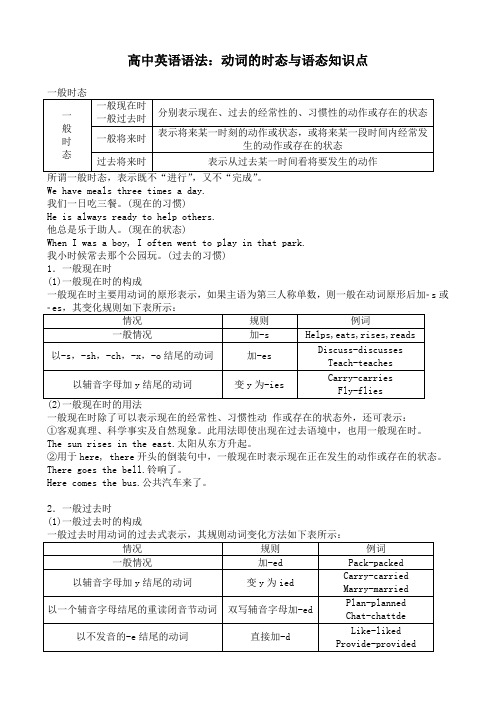
高中英语语法:动词的时态与语态知识点We have meals three times a day.我们一日吃三餐。
(现在的习惯)He is always ready to help others.他总是乐于助人。
(现在的状态)When I was a boy, I often went to play in that park.我小时候常去那个公园玩。
(过去的习惯)1.一般现在时(1)一般现在时的构成一般现在时主要用动词的原形表示,如果主语为第三人称单数,则一般在动词原形后加s或一般现在时除了可以表示现在的经常性、习惯性动作或存在的状态外,还可表示:①客观真理、科学事实及自然现象。
此用法即使出现在过去语境中,也用一般现在时。
The sun rises in the east.太阳从东方升起。
②用于here, there开头的倒装句中,一般现在时表示现在正在发生的动作或存在的状态。
There goes the bell.铃响了。
Here comes the bus.公共汽车来了。
2.一般过去时(1)一般过去时的构成(2)一般过去时的用法一般过去时除了可以表示过去经常性、习惯性的动作或存在的状态外,还有以下用法:①want, hope, think, intend等动词的一般过去时往往表示“过去原……”之意。
I thought he was an honest man.我原以为他是个老实人。
He didn't intend to hurt you.他本来没打算伤害你。
②wonder的一般过去时有时也可表示现在的行为,但口气要比用一般现在时更加委婉、客气。
I wondered if you could do me a favour.我不知道你能否帮我一个忙。
③used to+动词原形,表示过去的习惯性动作而现在已经不再发生了。
We used to spend our vacation in the mountains.我们以前常常在山里度假。
高中英语知识点归纳语法动词时态与语态的使用
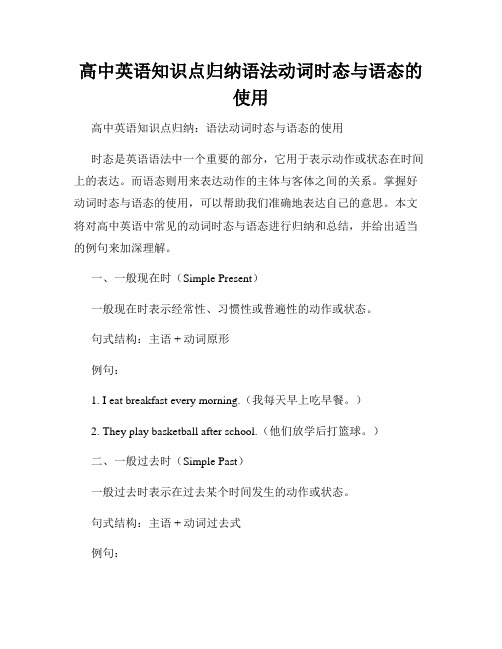
高中英语知识点归纳语法动词时态与语态的使用高中英语知识点归纳:语法动词时态与语态的使用时态是英语语法中一个重要的部分,它用于表示动作或状态在时间上的表达。
而语态则用来表达动作的主体与客体之间的关系。
掌握好动词时态与语态的使用,可以帮助我们准确地表达自己的意思。
本文将对高中英语中常见的动词时态与语态进行归纳和总结,并给出适当的例句来加深理解。
一、一般现在时(Simple Present)一般现在时表示经常性、习惯性或普遍性的动作或状态。
句式结构:主语 + 动词原形例句:1. I eat breakfast every morning.(我每天早上吃早餐。
)2. They play basketball after school.(他们放学后打篮球。
)二、一般过去时(Simple Past)一般过去时表示在过去某个时间发生的动作或状态。
句式结构:主语 + 动词过去式例句:1. We went to the park yesterday.(昨天我们去了公园。
)2. She studied English last night.(昨晚她学习了英语。
)三、一般将来时(Simple Future)一般将来时表示将来某个时间将要发生的动作或状态。
句式结构:主语 + will + 动词原形例句:1. He will go to Beijing next week.(下周他将去北京。
)2. They will visit their grandparents this summer.(今年夏天他们将去看望他们的祖父母。
)四、现在进行时(Present Continuous)现在进行时表示现在正在进行的动作。
句式结构:主语 + am/is/are + 动词 -ing例句:1. She is watching TV at the moment.(她此刻正在看电视。
)2. We are studying for the exam now.(我们现在正在备考。
高三英语高考语法知识点归纳总结动词的时态和语态
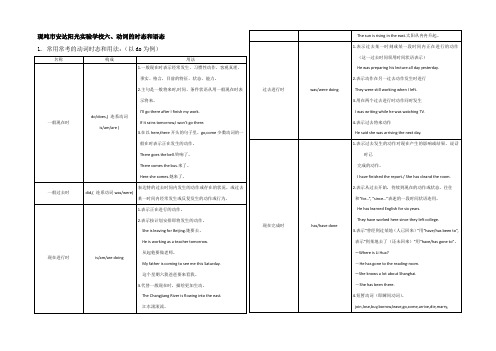
I read the novel last month. (只说明上个月看了,不涉及现在是否记住)
现在完成时与现在完成进行时的比较
着重表示动作的结果时,用现在完成时
I have read that book.我读过那本书了。(知道那本书的内容)
着重表示动作一直在进行,即动作的延续性时,则用现在完成进行时
(只说明他过去当过木匠不涉及到现在)
一般过去时只表达过去的动作或状态
Hello, I ____ you were in London. How long _________ here?
A. don’t know; were you B. hadn’t known; are you
C. haven’t known; areD. didn’t know; have you been
—Hi, Tracy, you look tired.
—I am tired. I _______ the living room all day.
A. paintedB. had painted
C. have been paintingD. have painted
说明:强调动作从过去到现在的延续
— Oh, I’m terribly sorry. _______.
A. I’m not noticing.B. I wasn’t noticing.
C. I haven’t noticed.D. I don’t notice.
说明:对话的后者显然是在解释刚才不小心冒犯对方时正在做的事情.
一般过去时与过去进行时的比较
Here she comes.她来了。
一般过去时
高中英语语法:动词的时态与语态

高中英语语法:动词的时态与语态We have meals three times a day.我们一日吃三餐。
(现在的习惯)He is always ready to help others.他总是乐于助人。
(现在的状态)When I was a boy, I often went to play in that park.我小时候常去那个公园玩。
(过去的习惯)1.一般现在时(1)一般现在时的构成一般现在时主要用动词的原形表示,如果主语为第三人称单数,则一般在动词原形后加s或-一般现在时除了可以表示现在的经常性、习惯性动作或存在的状态外,还可表示:①客观真理、科学事实及自然现象。
此用法即使出现在过去语境中,也用一般现在时。
The sun rises in the east.太阳从东方升起。
②用于here, there开头的倒装句中,一般现在时表示现在正在发生的动作或存在的状态。
There goes the bell.铃响了。
Here comes the bus.公共汽车来了。
2.一般过去时(1)一般过去时的构成(2)一般过去时的用法一般过去时除了可以表示过去经常性、习惯性的动作或存在的状态外,还有以下用法:①want, hope, think, intend等动词的一般过去时往往表示“过去原……”之意。
I thought he was an honest man.我原以为他是个老实人。
He didn't intend to hurt you.他本来没打算伤害你。
②wonder的一般过去时有时也可表示现在的行为,但口气要比用一般现在时更加委婉、客气。
I wondered if you could do me a favour.我不知道你能否帮我一个忙。
③used to+动词原形,表示过去的习惯性动作而现在已经不再发生了。
We used to spend our vacation in the mountains.我们以前常常在山里度假。
- 1、下载文档前请自行甄别文档内容的完整性,平台不提供额外的编辑、内容补充、找答案等附加服务。
- 2、"仅部分预览"的文档,不可在线预览部分如存在完整性等问题,可反馈申请退款(可完整预览的文档不适用该条件!)。
- 3、如文档侵犯您的权益,请联系客服反馈,我们会尽快为您处理(人工客服工作时间:9:00-18:30)。
一、动词的时态和语态名称构成用法一般现在时do/does,( 连系动词is/am/are )1.一般现在时表示经常发生、习惯性动作、客观真理、科学事实、格言,目前的特征、状态、能力等。
2.主句是一般将来时,时间、条件状语从句中用一般现在时表示将来。
I’ll go there after I finish my work.If it rains tomorrow,I won’t go there.3.在以he re,there开头的句子里,go,come等少数动词的一般在时表示正在发生的动作。
There goes the bell.铃响了。
There comes the bus.汽车来了。
Here she comes.她来了。
一般过去时did,( 连系动词was/were)表达特定的过去时间内发生的动作或存在的状况,或过去某一时间内经常发生或反复发生的动作或行为。
现在进行时is/am/are doing 1.表示正在进行的动作。
2.表示按计划安排即将发生的动作。
She is leaving for Beijing.她要去北京。
He is working as a teacher tomorrow.从明天起他要做老师。
My father is coming to see me this Saturday.这个星期六我爸爸要来看我。
3.代替一般现在时,描绘更加生动。
The Changjiang River is flowing into the east.长江江水滚滚向东流。
The sun is rising in the east.太阳从东方冉冉升起。
过去进行时was/were doing 1.表示过去某一时刻或某一段时间内正在进行的动作(这一过去时间须用时间状语表示)He was preparing his lecture all day yesterday.2.表示动作在另一过去动作发生时进行They were still working when I left.3.用在两个过去进行时动作同时发生I was writing while he was watching TV.4.表示过去将来动作He said she was arriving the next day.现在完成时has/have done 1.表示过去发生的动作对现在产生的影响或结果,说话时已完成的动作。
I have finished the report./ She has cleand the room.2.表示从过去开始,待续到现在的动作或状态,往往和“for...”, “since...”表述的一段时间状语连用。
He has learned English for six years.They have worked here since they left college.3.表示“曾经到过某地(人已回来)”用“have/has been to”,表示“到某地去了(还未回来)”用“have/has gone to”。
—Where is Li Hua?-He has gone to the reading-room.—She knows a lot about Shanghai.-She has been there.4.短暂动词(即瞬间动词),join,lose,buy,borrow,leave,go,come,arrive,die,marry, finish,complete,begin,start,break out等,在完成时态中,其肯定式不能和表示一段时间的状语连用。
不能说:He has joined the army for three years.要翻译“他已参军已经三年了。
”可采用①“ago法”He joined the army three years ago.②“延续法”H e has been in the army for three years.③“since法”It is/has been three years since he joined the army.过去完成时had done 1.表示在过去某一时间以前已经完成的动作。
He had shut the door before the dog came up. Everything had been all right up till this morning.2.表示动作或状态从过去某个时刻开始一直延续到另一个过去时刻才完成,甚至还要继续下去。
At the age of ten,he had learned 500 English words.He had been ill for a week when we learned about it. 3.常用hope,expect,think,intend,want,suppose等动词的过去完成时来表示未实现的希望、打算或意图。
We had expected that you would be able to win the match.将来完成时will/shall have done 用来表示在将来某个时刻(前)将完成的动作。
常和by短语,when,before引起的时间状语连用。
We will have finished senior Book 2 by the end of this term.现在完成进行时has/have been doing用来表示从过去某一时刻开始一直持续到现在(还要继续下去)的动作。
He has been doing the maths problemssince 8:00.过去完成进行时had been doing表示动作或状态从过去某个时刻开始一直延续到另一个过去时刻才完成,还将继续下去。
一般将来时will/shall dois/am/are going to一般将来时表示将来要发生的动作和存在的状况(详见下面2.一般将来时的特殊表达方式的比较)dois/am/are(about)to do过去将来时would/should dowas/were going todowas/were(about)to do1.相对于过去某一时刻而言即将发生的动作或存在的状态He told me he would go to Beijing.他告诉我他将去北京。
I was told that he was going to return home.有人告诉我他准备回家。
2. would do(表示过去的习惯)总是,总会,常常He would sit silent for hours.他常常接连好几个小时默默地坐着。
2.一般将来时的特殊表达方式的比较将来时用法例句1 be + doing 进行时表将来go, come, start, move, leave,arrive等词可用进行时表示按计划即将发生的动作He is moving to the south.Are they leaving for Europe?2 be about to + 动词原形表示安排或计划中的马上就要发生的动作,后面一般不跟时间状语I was about to leave when the bell rang.The meeting is about to close.3 be to + 动词原形表示按计划进行或征求对方意见We’re to meet at the school gate at noon.4 一般现在时表将来时刻表上或日程安排上早就定好的事情,可用一般现在时表示将来The meeting starts at five o’clock.The plane leaves at ten this evening.3.容易混淆的时态比较项目区别例句一般过去时与现在完成时的现在完成时强调过去动作对现在产生的影响或造成的结果We haven’t heard from Jane for a lo ng time. What do you suppose _______ to her?A. was happeningB. happensC. has happenedD. happened说明:说话者强调Jane 目前的状况.Mr. Lee, who ________ as a carpenter for over 10 years, is n ow a very famous statesmanA. has workedB. had workedC. workedD. works(只说明他过去当过木匠不涉及到现在)表达过去的动 C. haven’t kn own; are D. didn’t know; have you been时的比较着重表示动作一直在进行,即动作的延续性时,则用现在完成进行时—Hi, Tracy, you look tired.—I am tired. I _______ the living room all day.A. paintedB. had paintedC. have been paintingD. have painted 说明:强调动作从过去到现在的延续现在进行示现在某个时正在进行的动I don’t really work here. I ____ until the new secretary _______.A. just help out; comesB. have just helped out; will comeC. am just hel ping out; comesD. will just help out; has comeII. 动词的被动语态常用被动语态构成常用被动语态构成1 一般现在时am/is/are done 6 过去进行时was/were being done2 一般过去时was/were done 7 现在完成时have/has been done3 一般将来时shall/will be done 8 过去完成时had been done4 过去将来时should/would be done 9 将来完成时will/would have been done5 现在进行时am/is/are being done 10含有情态动词的can/must/may be done注意事被动语态的否定式是在第一个助动词或情态动词后加not,短语动词的被动态不可漏掉其中介副词。
固定结构be going to,used to,have to, had better变为被动态时,只需将其后的动词变为被动态。
